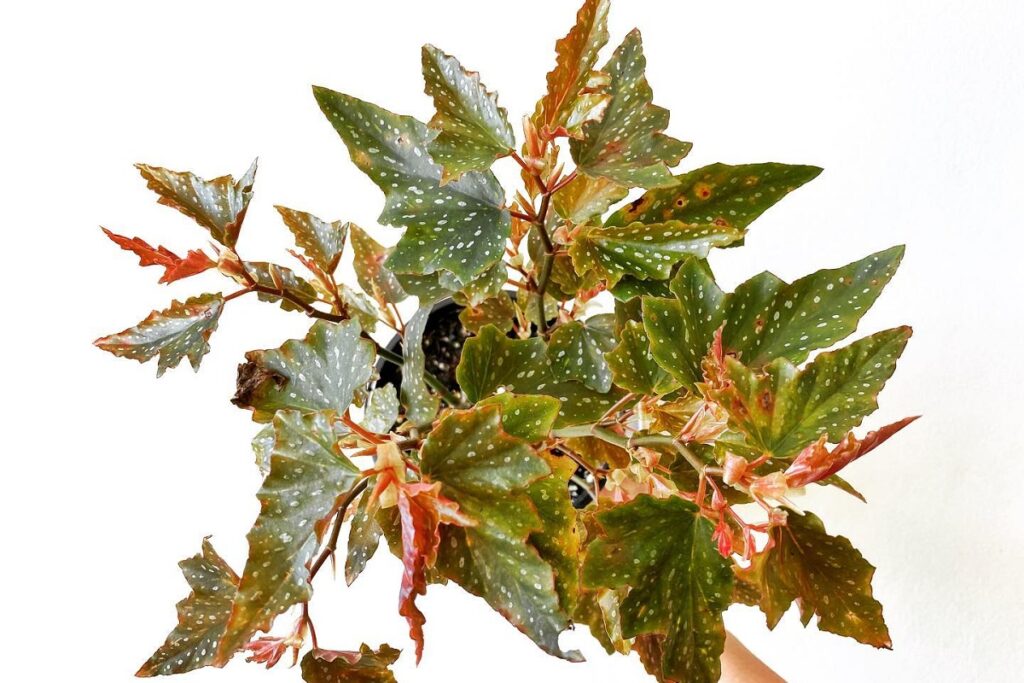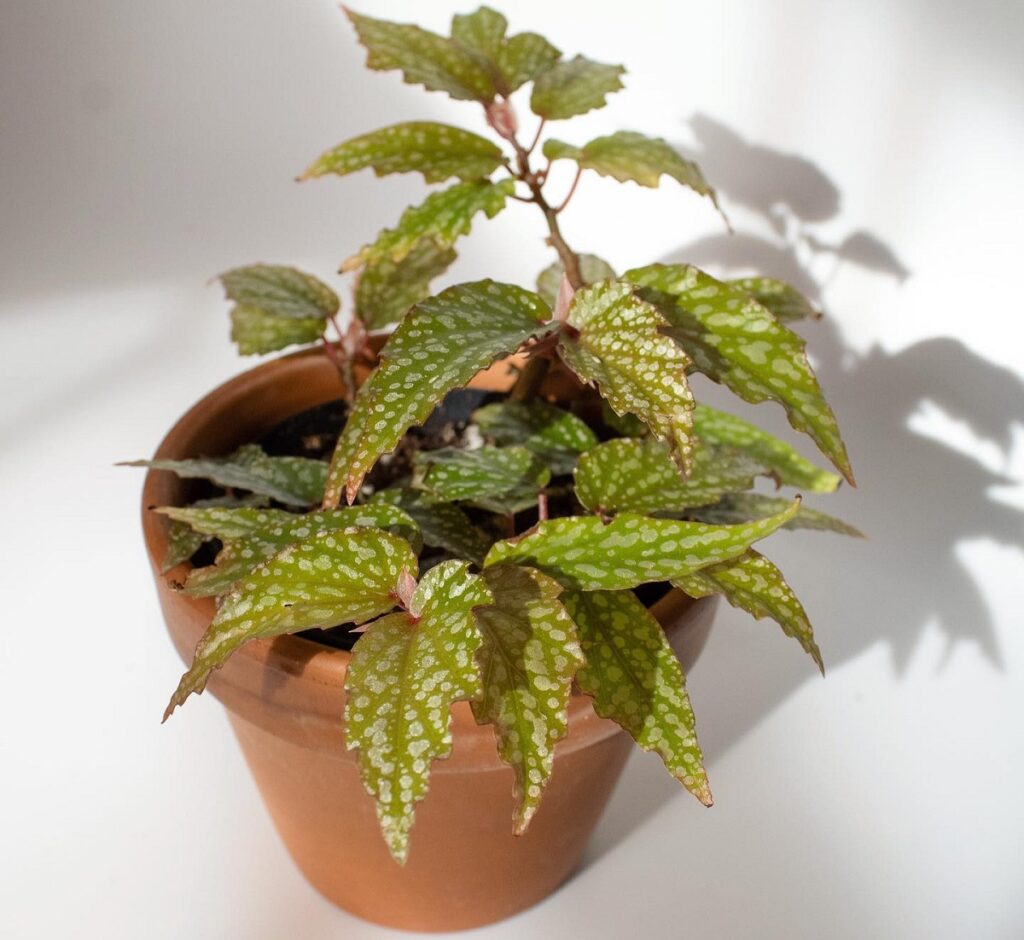Are you new to gardening and want to give Begonia medora a try? If so, then this Begonia medora care guide is just what you need! Growing Begonias can be an enjoyable experience but only if you know the right way to care for them. In this article, I’ll provide all the information needed on how to properly take care of your plant as well as tips on propagating it successfully.
Doing things like providing adequate sunlight, proper watering techniques and more will help ensure that your Begonia stays as healthy and vibrant as possible throughout its life cycle. And with my step-by-step instructions, even novice gardeners will have no trouble learning how to propagate their plants from seed or stem cuttings—giving them plenty of opportunities to create beautiful blooms year after year.
So if you’re ready to start creating a lush landscape full of colorful Begonia medora plants, keep reading for everything you need to know about caring for these lovely plants.

Contents
Begonia medora Care Guide
Light Requirements
Light is an important factor in the care of Begonia medora. It prefers indirect sunlight or a few hours each day of direct sunlight for optimal growth. Too much sun can cause its leaves to scorch and turn brown. It also needs moist soil and warm temperatures to thrive, so it’s best kept indoors if your climate isn’t mild enough to provide these conditions outdoors. If you are growing it inside, be sure not to place it too close to a window where sunlight might hit directly throughout the day.
Angel wing begonias do quite well with bright light from fluorescent lighting as long as they get at least 8–12 hours per day; however, make sure that no lights shine on them directly during their rest period when the lights are off. Proper light requirements will help keep your plant healthy and happy!
Watering Requirements
When it comes to watering your Begonia medora, the key is moderation. Never give them too much water and always let the soil dry out between waterings. To maintain a healthy balance, aim for about two cups of water every time you do decide to water them—no more than that! If you find yourself having to water your begonias often, consider cutting back on the amount of water you’re giving each plant.
Also, be sure not to leave your plants sitting in excess amounts of standing water as this can cause root rot and lead to other problems with their health. A great way to ensure your plants don’t stay damp for long periods of time is by setting up a pebble or rock tray underneath the pot so that any extra moisture will evaporate quickly and prevent excessive wetness from occurring.
Some signs that may indicate your Begonia medoras need more or less water include wilting foliage, yellowing leaves, or droopiness due to dehydration; all of which are symptoms of either overwatering or underwatering. Be mindful when caring for these lovely plants and never allow them to experience extended periods of drought or suffer from water stress. Here’s a helpful checklist:
- Aim for 2 cups of water per plant at a time
- Avoid leaving your plants in standing excess amounts of water
- Place a pebble/rock tray under pots for drainage
- Monitor signs such as wilting foliage, yellowing leaves & drooping due to dehydration
- Don’t overdo it but also avoid prolonged droughts

Soil Requirements
Now that you know how to keep your Begonia medora well-watered, let’s talk about soil requirements. When it comes to caring for your plant, having the right potting mix is key! Generally speaking, a good blend of soil mixes is best for this species. You’ll want something that will be both lightweight and well-draining—try combining equal parts of rich potting soil with perlite. This combination should ensure that your Begonia medora gets all the nutrients it needs while also providing adequate drainage so its roots don’t become waterlogged.
When you’re ready to repot your Begonia medora, make sure to use fresh potting soil rather than recycled or used ones as they may contain pests or diseases which could harm the health of your plant. To avoid these issues altogether, look for high-quality potting soils specifically designed for begonias when shopping around—this way you can rest assured knowing that everything contained in the soil will benefit your precious houseplant!
Fertilizer Requirements
Fertilizers can help keep your begonias healthy and thriving. A balanced fertilizer such as a 10-10-10 or 20-20-20 should be applied to the soil every two weeks during the growing season (spring through summer), at half strength. During winter months, fertilizing should cease altogether. It’s important not to overfertilize as this can cause damage or even death to the plant.
Temperature And Humidity Requirements
When it comes to the Begonia medora, temperature and humidity are two important factors for keeping them healthy. Warmer air temperatures of 65-75 degrees Fahrenheit (18-24 Celsius) are ideal, with cooler nighttime temperatures ranging between 50-65F (10–18C). It’s best not to let temperatures drop below 50°F (10°C) as this can cause damage to your plant.
Humidity should remain at 60% or higher, as this plant loves moist conditions. To increase the level of humidity in a room try placing your begonia on top of a shallow tray filled with pebbles and water. This will help create an environment that mimics its natural tropical habitat. A warm mist humidifier can also be used to maintain optimal levels of moisture in the atmosphere around the plant. With adequate temperature and humidity levels met, your Begonia medora is sure to thrive!
Common Pests
When it comes to pests, the Begonia medora is fairly resilient. However, if you want to keep your plant happy and healthy, there are a few things to be aware of. Warm temperatures can attract spider mites so make sure you check for these regularly and take action quickly if needed. If left untreated, they can cause serious damage to the foliage of your Begonia medora. It’s also important that your begonia get ample sunlight throughout the day—this will help prevent pest infestations as well as stimulate growth.
If an infestation does occur, try using insecticidal soap or neem oil spray on the affected area. Be sure to follow all directions closely when applying any type of pesticide or fungicide in order to ensure safe use and maximum effectiveness. Doing regular inspections of your Begonia medora and taking precautionary measures should help protect it from potential pests.
These simple steps will ensure that your Begonia medora remains healthy and pest-free!

Common Diseases
Now that you’ve taken the necessary steps to prevent and treat pests, it’s time to tackle diseases. Common disease problems for Begonia medora include root rot, botrytis blight, and leaf spot. Root rot is a fungal infection caused by overwatering or poor drainage. To avoid this problem, make sure your soil is well-draining or pot in containers with holes at the bottom. If you already have root rot, remove any affected roots and repot your plant into fresh soil.
Botrytis blight can be recognized by its grayish spots on leaves which may eventually turn brown and become dry. This disease likes wet conditions so keep foliage dry when watering, water from below rather than above, and prune away damaged areas of foliage right away if present. Leaf spot occurs when plants are kept in overly moist environments; again drying off the foliage often helps reduce the occurrence of this type of disease as does removing any infected leaves immediately.
Following these tips will help ensure healthy growth for your Begonia medora over time!
When And How To Repot Begonia Medora
Although begonias are generally very low-maintenance plants, they do need to be repotted from time to time. The best time to repot a Begonia medora is during the spring. This is when the begonia is most likely to be in active growth.
When you go to repot your begonia, make sure you have a pot that is slightly larger than the one it is currently in. This will give the begonia more room to grow. Remove the begonia from its pot and gently loosen the roots from the sides of the root ball. If the plant has become root bound, you may need to cut the roots in order to free them.
Next, fill the new pot with a mix of potting soil and perlite. Place the begonia in the pot and fill in around the root ball with additional soil. Make sure the soil is firmly packed down. Once complete, water the begonia until the water runs freely from the drainage hole.
Your Begonia medora should now be repotted and ready to grow!

How To Propagate Begonia Medora
Now that you know the repotting requirements for Begonia medora, it’s time to learn how to propagate this charming plant. Propagating Begonia medora is easy and rewarding! Here are four ways how to propagate your begonias:
- Leaf Cutting – Take a healthy leaf with its stem attached, then snip off the bottom of the stem at an angle. Place the cutting in moist soil or water until roots develop. When new growth appears, transplant it into potting mix with proper drainage.
- Central Cane Cuttings – Carefully cut sections from mature stems about 6-8 inches long and remove any leaves near the bottom of each cane section. Insert these canes in moistened soil up to their nodes and cover lightly with a soil/peat moss combination. Keep buds pointing upwards and place in indirect light indoors until rooted.
- Division – Divide clusters when re-potting larger plants by gently pulling them apart at the root level and replanting each division into separate pots filled with fresh potting mix that provides good drainage. Water immediately after planting divisions deep enough so there is no chance of drying out between waterings.
- Air Layering – Select the best branches for air layering. Make shallow cuts from top to bottom along the selected branch(es) and wrap sphagnum moss around the wounded area(s), securing it tightly with twine or plastic wrap before covering completely with an additional layer of sphagnum moss and sealing securely again using twine or plastic wrap; keep damp while rooting takes place over several weeks period before severing rooted portion from the parent plant and transferring it into an individual container filled with a well-draining potting medium mixture.
Conclusion
In conclusion, Begonia medora is an attractive and easy-to-care-for plant. With the right light, watering, soil, fertilizer, temperature and humidity requirements it can thrive in any home or garden setting. While it is not a rare species, you should take special care when propagating these plants as they are relatively slow growing. With correct handling and proper maintenance, this stunning houseplant will bring beauty to your home for many years.
I have enjoyed learning about caring for my own Begonia medora—from providing the necessary lighting conditions to repotting every few years. It truly has been rewarding seeing how much more vibrant its foliage becomes with just a little bit of extra attention! I highly recommend Begonia medora if you’re looking for something unique yet low-maintenance that will brighten up your home or outdoor area.
All in all, Begonia medora makes an excellent choice for anyone looking to add some color and interest to their living space without taking on too much of a commitment. Once it’s settled in properly, it requires minimal upkeep while still delivering beautiful results! And who doesn’t love that?
